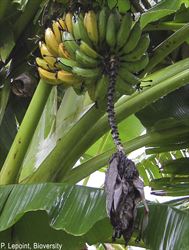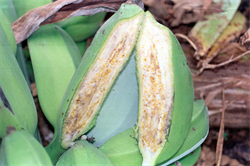- Narrow. Initially in Ethiopia. Now throughout East and Central Africa.
- Major bacterial disease of banana and enset, and their wild varieties. ABB are especially susceptible. Massive losses in Uganda beginning in 2001.
- Two routes of infection:
- (i) Suckers already infected at planting or later from contaminated knives when pruning or harvesting: leaves turn yellow, collapse and hang down around the stem; internally, vascular tissues are cream/yellow/pink, and spaces within leaf sheaths fill with ooze.
- (ii) Insects carring bacteria to male flowers and their covering leaves. Male buds (‘bell’) blacken and rot, fruits develop internal reddish rots; fruit (‘fingers’) yellow prematurely (although often the whole bunch remains green), and vascular tissues of flower stalk turn yellow-orange. Bacteria then travel to rest of plant, followed by yellowing, wilting, death, and sucker infection.
- Spread: infected suckers, knives, insects, fruits. Infection from soil is uncertain as survival is short. Biosecurity: risk from unofficial introduction of diseased cuttings for propagation, and trade in fruit. Official movement of germplasm should always follow the FAO/IPBGR Technical Guidelines.
- Biocontrol: none.
- Cultural control: most important recommendations for smallholders are: (i) monitoring and removal of disease plants as soon as seen, but NOT necessarily the entire mat - not all suckers become systemically infected; (ii) removal of unopened male flower buds (called 'de-budding') using forked stick; and (iii) keeping cutting tools clean and free from bacteria (bleach). Others: disease-free suckers; do not plant near diseased plots (especially downwind); limit access to visitors/workers/animals; bag flowers after emergence until fruit set (if bell removed); check availability resistant varieties from Bioversity International and IITA.
- Chemical control: not a method to use.








